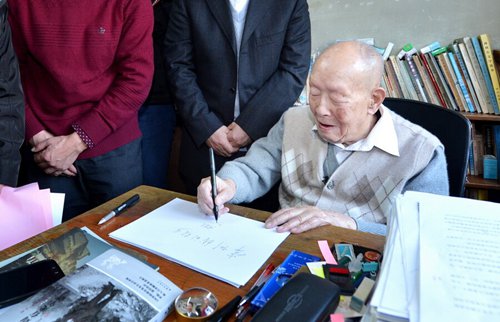ARTS / ART
Tributes to Zhou Youguang stir debate over who deserves the title: the ‘father of Pinyin’
The birth of ‘Hanyu Pinyin’

Zhou Youguang Photo: IC
Pinyin, the official Romanization system for standard Chinese, is widely used in learning how to read Chinese characters.
After the death of famed Chinese linguist Zhou Youguang on Saturday, Chinese media outlets across the nation published articles memorializing Zhou as the "father of Pinyin." However, this has led to a backlash from those who feel that Zhou's contribution to the development of Pinyin has been exaggerated.
Some argue that since the project which developed the Hanyu Pinyin system was first initiated by famed educator Wu Yuzhang, Wu should get the title. Others argue that Zhou was just one of a number of members of the committee that established the Hanyu Pinyin system and so the title takes focus away from the fact that it was a group effort. Meanwhile, there are also those that point out that the Hanyu Pinyin system wasn't an original creation as it didn't change much from previous systems that used the Latin alphabet.
It certainly is true that while the Hanyu Pinyin system was adopted in the 1950s, its origins can be traced back to the Ming Dynasty (1368-1644).
Early years
During the late Ming Dynasty, Western missionaries came to China to spread Christianity. In order to help these missionaries learn Chinese more easily, the Latin alphabet was adopted for textbooks on the Chinese language.
In 1605, the renowned Italian Jesuit Matteo Ricci published Xizi Qiji (Miracle of Western Letters), in which 4 chapters written in Chinese are accompanied by phonetic notation using the Latin alphabet. The book is considered the first publication to use the Latin alphabet to spell out the Chinese language. The only known copy of the work can be found in the Vatican Library.
Twenty years later, Belgian Nicolas Trigault finished his three-volume work Xiru Ermuzi (Lit: Aid to the Eyes and Ears of Western Literati), which he published in 1626 in Hangzhou, East China's Zhejiang Province.
In his work, Trigault built on Ricci's system of using the Latin alphabet, adding the use of tone marks to represent Chinese's tonal nature.
Trigault's system opened up a simple way for students to learn how to pronounce Chinese characters. This system eventually caught the attention of Chinese such as Fang Yizhi, a phonetician who lived during the late Ming and early Qing (1644-1911) dynasties. Fang was one of the first Chinese to use this Romanization system to record the pronunciation of Chinese characters.
However, while both Ricci and Trigaults' systems were widely used by Westerners over the next 200 to 300 years, they didn't prove popular among Chinese.
Call for innovation
The push for a Romanization system, however, did start to take hold after the First Sino-Japanese War (1894-1895).
The unfairness of the Treaty of Shimonoseki enraged the populace of China, especially patriotic intellectuals. These intellectuals concluded that education was one of the major factors that put China at a disadvantage during the war, as such they agreed that Chinese characters should be revolutionized in order to popularize education and save the country.
Tan Sitong, a major figure in intellectual circles, put forward the idea that Chinese characters be abandoned in favor of a Romanization system. This suggestion received the support in various circles throughout China, thus leading to the beginnings of the Hanyu Pinyin movement.
During the last 10 years of Qing Dynasty, there were 27 different standards for Chinese Pinyin, most of which were designed to represent the pronunciation of local dialects. Among these, Lu Gangzhang's system was the most widely accepted.
Development after 1949
In 1949, Wu Yuzhang wrote to Mao Zedong stating the need to reform the writing system. Mao entrusted scholars Guo Moruo, Mao Dun and Ma Xunlun to look into Wu's proposal and provide feedback.
In October 1949, a Chinese character reform committee was established; one of its responsibilities was to conduct research into a Pinyin system.
The committee was put under the direct control of the State Council, China's cabinet, in 1954. It received over 6,000 proposals, including ones that made use of Chinese character strokes, Latin letters, Cyrillic and numbers.
The Latin alphabet was chosen for the Hanyu Pinyin system as it was seen as more convenient for international communication.
Hanyu Pinyin was first published by the central government in 1958. In 1982 it was adopted by the International Organization for Standardization as an international standard.
